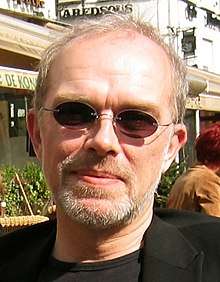Stephen Partridge
Stephen Partridge (born 1953) is an English video artist [1] who studied under David Hall and his career as an artist, academic and researcher, helped to establish video as an art form in the UK.[2][3]
Stephen Partridge (aka Steve Partridge) | |
|---|---|
 | |
| Born | March 19, 1953 |
| Education | Maidstone College of Art, Maidstone Royal College of Art, London |
| Known for | Video art, Photography |
Notable work | Monitor (1975) Quattro Minuti di Mezzogiorno (2010) |
| Movement | Video Art |
Life and work
Stephen Partridge attended Maidstone College of Art and the Royal College of Art. He was in the "landmark" video shows of the 1970s including "The Video Show" at the Serpentine in 1975, the "Video Show" at the Tate Gallery London in 1976 (where he exhibited the installation "8x8x8" [4][5][6]), the Paris Biennalle in 1977 and The Kitchen in New York in 1979. During the eighties he exhibited widely and also became interested in works for broadcast television and was commissioned by Channel 4 television to produce "Dialogue for Two Players" in 1984,[7][8] and "The Sounds of These Words",[9] again for Channel 4 in 1989.[10] The latter work was one of 19 productions for Channel 4 produced by his production company Fields and Frames Productions, under the series title TV Interventions which were designed to intervene in the broadcast schedule. Other commissioned artists included David Hall, Bruce McLean, David Cunningham, Ian Breakwell[11][12]
In 1976 he co founded London Video Arts in collaboration with David Critchley, Stuart Marshall, David Hall, Tamara Krikorian and others. This acted as a promotional agency, an artist-led workshop and a distribution service.[13] Hall and Partridge left the steering group of LVA in 1979 after a disagreement on future policy over non-selectivity distribution and promotion of artists' works.[14]
He was an academic researcher at Duncan of Jordanstone College of Art and Design (DJCAD) until 2019, and his major research projects include REWIND| Artists’ Video in the 70s & 80s and REWIND Italia: Italian Video art in the 1970s & 1980s. In 1984 he established The Television Workshop[15] at DJCAD to support artists and filmmakers' production and access to high-level broadcast technology including the Quantel Paintbox.[16] Over 400 productions were supported in this way from 1984- 1992 until desktop video pre-empted the need. Artists and filmmakers using The Television Workshop included Jeff Keen, Robert Cahen, Tamara Krikorian and many others.
Recent work includes a collaboration with Elaine Shemilt, "Quattro Minuti di Mezzogiorno", a HiDefinition Video installation.[17] Exhibited in Fuoriluogo 15 - Una Regressione Motivata, Limiti Inchiusi Arte Contemporanea, Campobasso, Molise, Italy. December 2010, January 2011. The exhibition included work by Fausto Colavecchia (IT), Douglas Gordon (GB), and was curated by Deirdre MacKenna, Director of Stills - Scotland's centre for photography in Edinburgh. In 2012 he was awarded a Royal Society of Edinburgh Caledonian European Research Fellowship to study and research in Italy.
In November 2014, TATE London, bought his seminal work Monitor (1974) as an installation.[18][19] It was selected for their 2014-17 re-hang at TATE Britain, BP Walk through British Art.[20]
References
- "Union List of Artist Names",
- "A Century of Artists' Film in Great Britain ", Exhibition at Tate Britain
- "A History of Artists' Film and Video in Britain, 1897-2004" David Curtis, (BFI Publishing 2006)
- Diverse Practices: A Critical Reader on British Video Art edited by Julia Knight (University of Luton/Arts Council England, 1996), page 177
- The Problematic of Video Art in the Museum 1968-1990 by Cyrus Manasseh (Cambria Press, 2009), pages 25,36, 101-105, 125
- "Art Now Lightbox" Archived 2011-08-01 at the Wayback Machine, Exhibition at Tate Britain
- https://vimeo.com/306557826 Dialogue for Two Players on Vimeo
- "Dialogue for Two Players "
- https://vimeo.com/138967862 The Sounds of These Words on Vimeo
- "Video Art, A Guided Tour " Catherine Elwes, (I B Taurus, 2005) page 134
- VIDEO ART: the early years
- BFI Database
- "A History of Video Art" Chris Meigh-Andrews, (Berg 2006), page 56
- "Reaching Audiences Distribution and Promotion of Alternative Moving Image" Julia Knight and Peter Thomas, Intellect (2012), page 146
- The Television Workshop
- http://www.whereiam.info/the-television-workshop-2/ Interview with Stephen Partridge about the Television Workshop
- https://vimeo.com/138967334 Quattro Minuti di Mezzogiorno on Vimeo
- https://www.tate.org.uk/art/artworks/partridge-monitor-t14346
- https://vimeo.com/19121750 Monitor on Vimeo
External links
Writings by Stephen Partridge
- A Kick in the Eye, Book chapter in Expanded Cinema, (David Curtis, A. L. Rees, Duncan White, and Steven Ball, eds), Tate Publishing, 2011
- Video: Incorporeal, Incorporated, Book chapter in Experimental Film and Video, Jackie Hatfield, Editor. (John Libbey Publishing, 2006; distributed in North America by Indiana University Press)
- A Small Survey of Early Works. Book chapter in Retrospektiv-Film-org videokunst| Norge 1960-90. Edited by Farhad Kalantary & Linn Lervik. Atopia Stiftelse, Oslo, (April 2011).
- REWIND: British Artists' Video in the 1970s & 1980s, (Sean Cubitt, and Stephen Partridge, eds), John Libbey Publishing, 2012.
- " REWIND | Italia, Early Video Art in Italy: I primi anni della videoarte in Italia. Leuzzi, L. (ed.) & Partridge, S. (ed.) 2016 New Barnet: John Libbey Publishing. 352 p.
- EWVA European Women’s Video Art in the 70s and 80s, Leuzzi, L., Shemilt, E., Partridge, S. (eds.) 2019, John Libbey Publishing New Barnet. 262 p. http://www.iupress.indiana.edu/product_info.php?cPath=1037_5888&products_id=809486